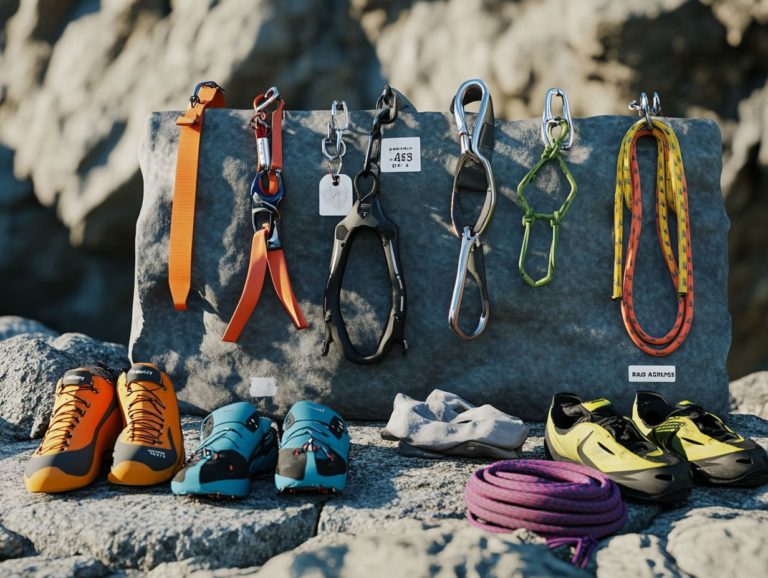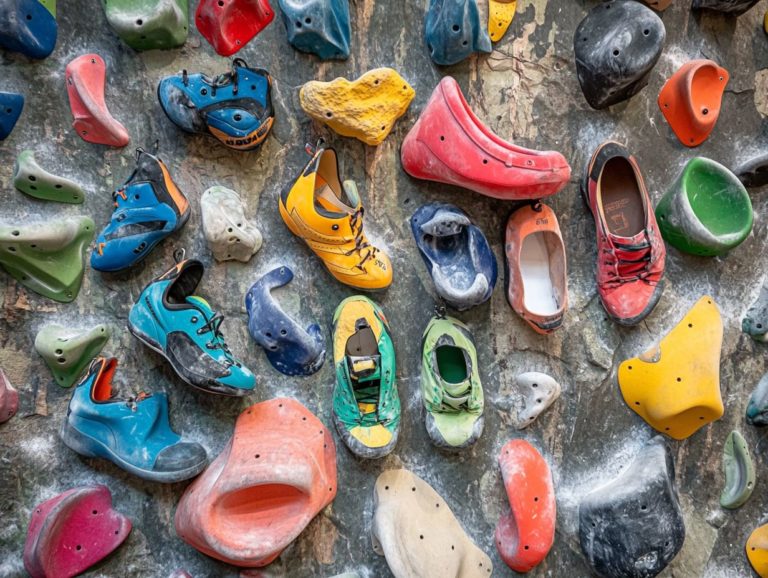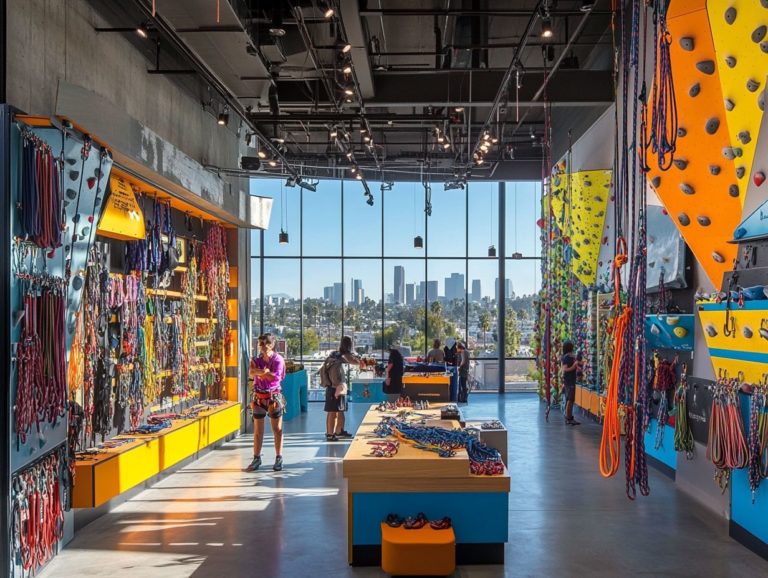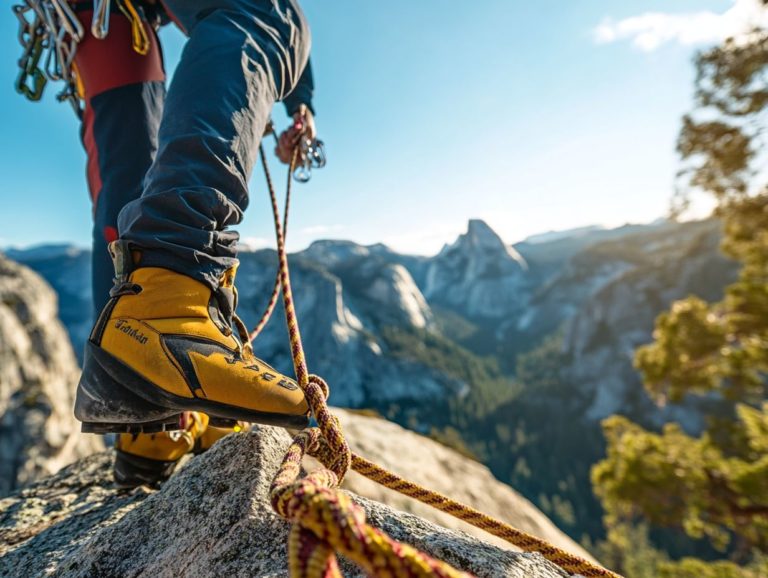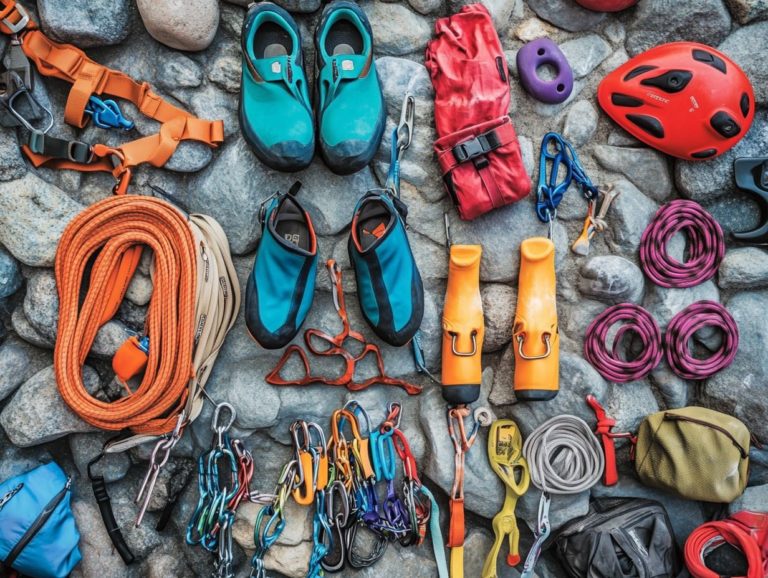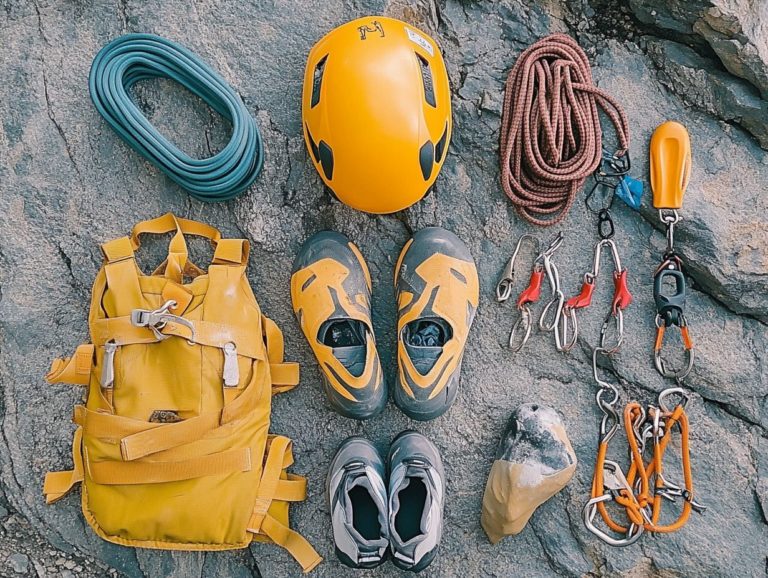The Impact of Weather on Climbing Gear
Climbing is an exhilarating adventure. However, the unpredictable nature of weather can greatly influence both your gear and safety. Understanding climbing weather is essential for any climber.
From temperature fluctuations and humidity to wind and precipitation, each weather condition presents its own challenges. These can enhance or hinder your climbing experience. As you plan your climbing adventures, it’s crucial to assess the various conditions you may face.
This article explores how different weather factors affect your climbing gear. It also offers tips for proper storage and maintenance, discusses climbing risks, and provides guidance on selecting the right gear for any climate.
Understanding these factors can elevate your climbing experience to new heights. Staying safe and performing at your peak while enjoying the fun of climbing is what every climber aims for.
Contents
- Key Takeaways:
- Types of Climbing Gear
- Weather’s Effect on Climbing Gear
- How to Protect Climbing Gear from Weather
- Weather-related Risks for Climbers
- Choosing the Right Gear for Different Weather Conditions
- Frequently Asked Questions
- What impact does weather have on properly assessing climbing gear for climbing environments?
- How does extreme heat affect climbing gear?
- What impact does precipitation have on climbing gear?
- Can wind affect climbing gear?
- How can I prepare my climbing gear for different weather conditions?
- What should I do if my climbing gear gets wet?
Key Takeaways:
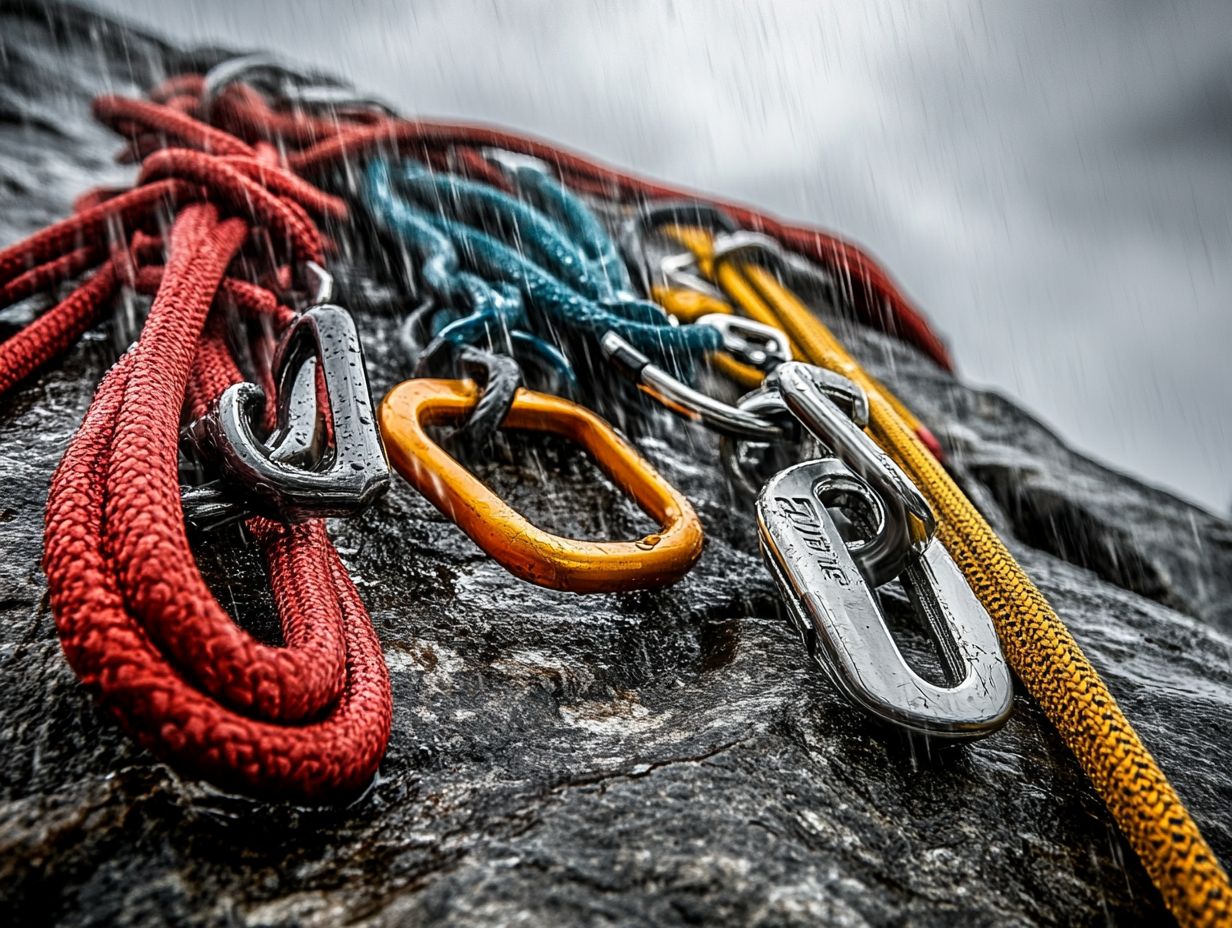
- Proper storage and maintenance are crucial in protecting climbing gear from the negative effects of temperature, humidity, wind, and precipitation.
- Always check the weather forecast to stay safe and take necessary precautions, such as having an emergency plan.
- Choosing the right gear for different weather conditions can significantly impact your safety and success. Research and invest in appropriate gear for specific conditions.
Types of Climbing Gear
Understanding the different types of climbing gear is essential for both novice and experienced climbers. Having the right equipment elevates your climbing performance and guarantees your safety during thrilling adventures on challenging routes.
From dynamic ropes to belay devices, each piece of climbing gear has a crucial purpose. This is especially important when facing the unpredictable weather in places like Bangalore during the monsoon season.
Weather’s Effect on Climbing Gear
Weather conditions can profoundly influence your climbing gear. Factors such as humidity, precipitation, and temperature directly impact the durability and performance of your equipment.
This is especially true during Bangalore’s monsoon season. Preparing for potential thunderstorms and wet conditions is essential. By understanding how these elements affect your gear, you can make informed choices that enhance climbing safety and minimize risks associated with adverse conditions.
Temperature and Humidity
Temperature and humidity are pivotal in shaping your climbing experience. They influence not just your comfort but also the performance and reliability of your gear.
In Bangalore s monsoon season, high humidity can dramatically reduce the friction of climbing holds. This makes it more challenging to maintain your grip, even with the most advanced climbing shoes.
Moreover, moisture can weaken the materials of your ropes and climbing devices, compromising your safety. To tackle these challenges, ensure your gear is well-maintained and kept dry when not in use.
Carrying a microfiber towel or a chalk bag can effectively keep your hands dry. Periodic gear inspections help you spot potential weaknesses before taking on a climb.
It’s essential to be aware of shifting weather conditions. If humidity levels are particularly high, it might be wise to opt for less technical climbing routes or consider indoor climbing to safeguard both your safety and the integrity of your equipment. Climbing gear designed for wet conditions becomes invaluable in such cases.
Wind and Precipitation
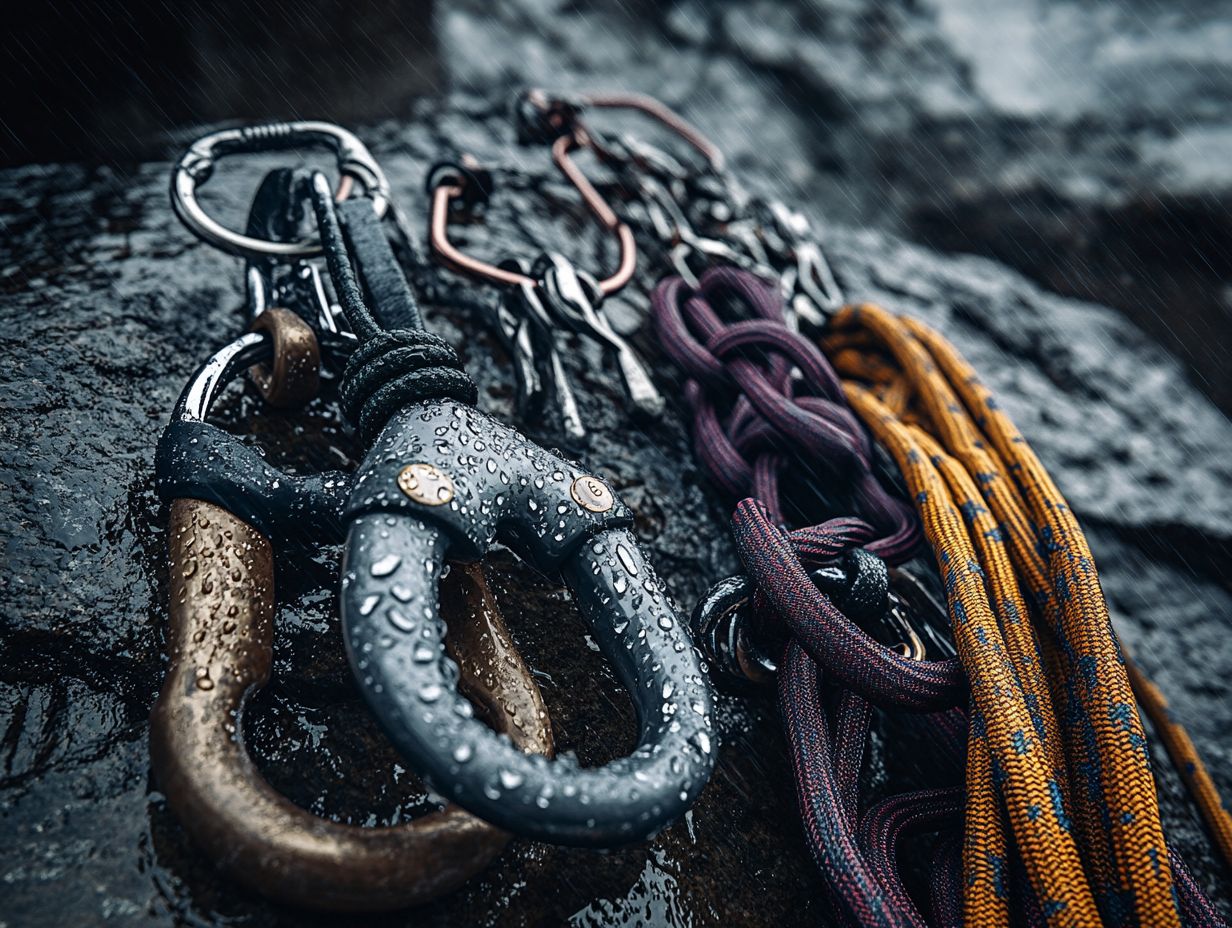
Wind and precipitation are important factors you must consider when evaluating climbing hazards. These elements create challenging conditions. They impact your safety and the routes you choose.
In areas like Bangalore during the monsoon season, heavy rains and strong winds can pose significant risks. It s essential to adapt your strategies and thoroughly prepare for potential weather-related challenges.
Understanding how these elements affect your climb is vital. Strong winds can lead to falling debris, while rain can make surfaces slippery, increasing the likelihood of accidents. Regularly checking weather forecasts and staying aware of changing conditions will help you make informed decisions. If bad weather is on the horizon, opt for routes that are less exposed.
It s also wise to carry gear like waterproof jackets and sturdy trekking poles to improve your stability and grip. Hone your decision-making skills. Learn when it s safer to turn back instead of pressing on, even if your goal seems close. Preparation, adaptability, and vigilance are your best allies in ensuring safety amid unpredictable weather.
How to Protect Climbing Gear from Weather
Protecting your climbing gear from the elements is crucial! It ensures your gear stays dependable, especially in unpredictable weather. By implementing proper storage and maintenance practices, including the use of climbing equipment designed for wet conditions, you can shield your gear from environmental factors.
This way, you ensure that it remains dependable during your climbing adventures even when faced with the challenges of the monsoon season.
Proper Storage and Maintenance
Proper storage and maintenance of your climbing equipment are essential practices. These steps extend the lifespan of your gear and play a critical role in climbing safety by minimizing the risks associated with equipment failure.
Regular checks and suitable storage conditions can thwart weather-related damage, particularly during wet conditions.
To keep your dynamic ropes in top shape, make sure they re coiled neatly and stored in a cool, dry place, away from direct sunlight. As for your belay devices devices used to control the rope during climbing they deserve some TLC too. Regular cleaning to remove chalk and grime is vital, as it can significantly impact their efficiency. Storing them in a designated gear bag will help reduce wear and tear.
Don t overlook other equipment like carabiners and harnesses. Inspect them for signs of wear, ensuring they re free from scratches and abrasions. By following these practices, you can significantly enhance both the performance and safety of your adventure gear, elevating your climbing experience to new heights.
Weather-related risks pose a considerable challenge for climbers, particularly in unpredictable climates like Bangalore. Here, thunderstorms and abrupt weather changes can lead to a host of climbing hazards.
Understanding these risks is essential for every climber. It s crucial to adopt effective safety precautions, ensuring that your climbing experience remains safe and enjoyable. By doing so, you can adapt your strategies to navigate the ever-changing conditions with confidence and stay informed and prepared to navigate the dangers before they catch you off guard!
Safety Precautions and Tips
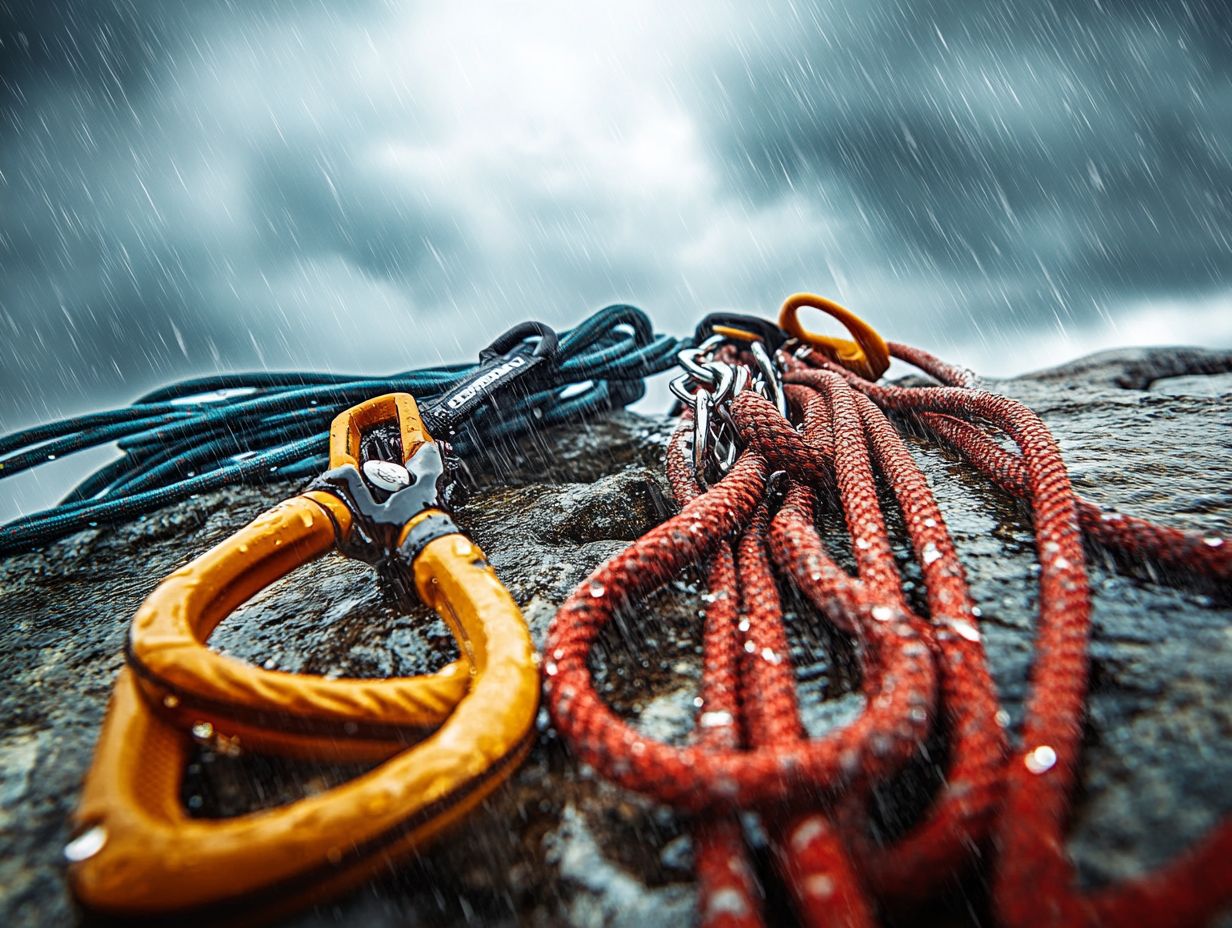
It’s vital for every climber to follow effective safety tips, especially when navigating challenging weather conditions in places like Bangalore during the unpredictable monsoon season. By using the right climbing techniques and leveraging communication tools, you can significantly enhance your safety measures and better prepare for unexpected scenarios.
Understanding the dynamics of weather patterns is crucial. Always check forecasts before you embark on an ascent. Techniques such as proper knot tying, maintaining three points of contact (keeping three parts of your body connected to the rock or wall for stability), and practicing self-rescue maneuvers (ways to help yourself if you get into trouble) are invaluable for reducing risks on the climb.
Carrying reliable communication devices like two-way radios or satellite phones is essential, particularly when visibility wanes or storms roll in quickly. Establishing clear signals and emergency protocols with your climbing partners can facilitate a swift response during crises, ensuring you all remain connected even in challenging conditions.
Lastly, never underestimate the importance of having a well-stocked first aid kit and a solid grasp of basic medical response principles; these preparations can be life-saving when the need arises.
Choosing the Right Gear for Different Weather Conditions
Selecting the appropriate gear for varying weather conditions is vital for climbers seeking to enhance their performance and ensure safety during adventures. In places like Bangalore, where the monsoon season presents distinct challenges, this becomes even more crucial.
By understanding the features of various climbing essentials, you enable yourself to make informed choices that elevate your climbing experience and mitigate the risks associated with unpredictable weather.
Recommended Gear for Different Weather Conditions
Selecting the right gear tailored to various weather conditions is essential for your climbing safety and performance, especially during the monsoon season in Bangalore. In these wet conditions, specialized climbing equipment can truly make a difference. From waterproof bags to specific climbing techniques, having the right gear allows you to tackle challenging scenarios with confidence.
For example, investing in high-quality waterproof boots, waterproof bags, and breathable rain jackets essential for wet conditions can protect you from harsh elements, ensuring both comfort and security. Understanding what impact weather has on gear selection can help you choose the right equipment. Climbing helmets equipped with moisture-wicking liners, vital for a comfortable climbing experience, are crucial for safety while maintaining ventilation. Moisture-resistant chalk bags are also critical for enhancing your grip and overall performance, especially if your climbing gear becomes wet. It is essential to dry it properly.
Using lightweight, quick-drying climbing harnesses is essential for your climbing adventures. This ensures that you maintain mobility without sacrificing safety, giving you peace of mind in unpredictable weather. Understanding climbing safety involves recognizing potential hazards. Portable emergency shelters are an invaluable part of your kit, providing an essential layer of preparedness for sudden downpours.
Frequently Asked Questions
What impact does weather have on properly assessing climbing gear for climbing environments?
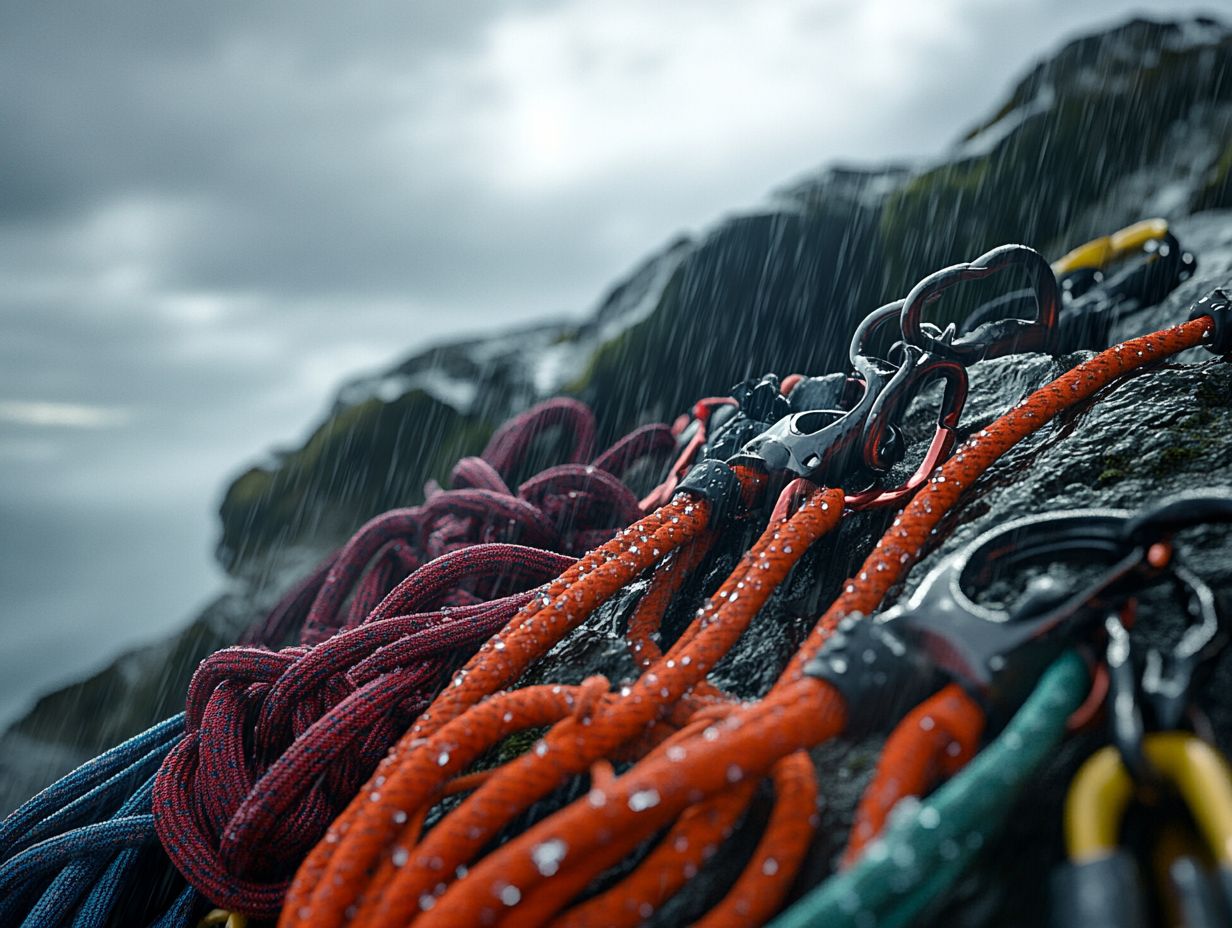
Weather dramatically affects climbing gear. It can change how safe and effective your equipment is. Extreme temperatures, precipitation, and wind can all impact the condition of climbing gear, making it important to properly assess and prepare for the importance of checking weather patterns before climbing.
How does extreme heat affect climbing gear?
Extreme heat can weaken climbing gear. Ropes, harnesses, and other equipment can become more prone to breaking, putting climbers at risk.
Store climbing gear in a cool, dry place. Avoid prolonged exposure to high heat.
What impact does precipitation have on climbing gear?
Rain or snow can seriously damage climbing gear. Wet ropes and harnesses become heavier, less flexible, and easier to break.
Always dry and inspect your gear after exposure to moisture. This step is crucial before using it again.
Can wind affect climbing gear?
Strong winds can significantly impact climbing gear. They can cause ropes to tangle and harnesses to shift, compromising safety.
Use proper anchors and techniques to secure your gear during windy conditions.
How can I prepare my climbing gear for different weather conditions?
Clean, dry, and inspect your climbing gear before each use. Always check the weather forecast for your climbing area.
Pack extra gear or clothing to stay prepared for sudden weather changes. This preparation ensures your safety.
What should I do if my climbing gear gets wet?
Dry and inspect wet climbing gear before using it again. Hang it in a well-ventilated area or use a fan to speed up drying.
Never use wet climbing gear, as it compromises safety and effectiveness.

